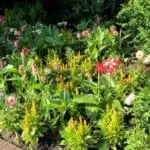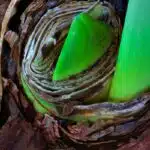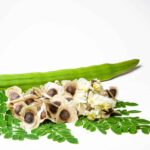Beauty and complexity intertwine in the world of plants, especially when it comes to caladium. This stunning plant is both striking in appearance and surprisingly easy to care for—a perfect combination for any gardener! With their bright colors and lush leaves, caladiums are sure to make a bold statement in your garden. But don’t be fooled by the beauty; there is much more than meets the eye when it comes to growing and caring for these exquisite plants.
Caladiums come in many varieties, ranging from white and pink to red and green. They thrive best in warm climates with plenty of shade and moisture, so they are ideal for those living in tropical areas. They can also be grown indoors as houseplants, making them a versatile option for all types of gardens. With just a few simple steps, you can have your own stunning caladium display that will bring life and color into your home or garden.
Ready to learn how? Read on to find out all you need to know about growing and caring for caladium! We’ll discuss everything from planting techniques to fertilizing schedules, so you can rest assured that you’ll have a thriving caladium garden in no time. Whether you’re looking for an easy-care houseplant or want something special for your outdoor space, this guide has got you covered!
Choosing A Caladium Variety
Choosing the right Caladium variety is the first step to a successful garden. To get started, it’s important to understand that there are four different kinds of Caladiums: Fancy Leaf, Carolinianum, Florida Fancy and Strap Leaf. Each one has its own unique characteristics that can make it a great choice for your specific needs. Depending on where you live, your climate, and what kind of look you’re going for in your garden, one type may be more suitable than another.
Fancy Leaf varieties are known for their large leaves and bright colors – perfect for adding a bit of color to any garden! Carolinianum types are known for their more subtle shades and tend to be easier to care for than other types. Florida Fancy varieties offer an array of colors but tend to require more maintenance than other varieties. Lastly, Strap Leaf types have narrow leaves with bold colors and can add a touch of drama to any garden.
Take some time to research the various types of Caladiums available and decide which one is best suited for your particular environment and needs. Consider things like sun exposure, soil type, water requirements and overall maintenance before making a decision – this will help ensure you get the best results from your plants! With so many options out there, it’s easy to find the perfect fit for your garden.
Deciding Where To Plant
When it comes to deciding where to plant caladiums, the possibilities are virtually endless. From a garden bed to a container, this flowering plant can be grown in multiple settings. Anachronistically speaking, with the right preparation and knowledge, one may be able to cultivate a flourishing patch of these exquisite beauties.
First and foremost, you’ll need to take into account your climate’s weather patterns and sunlight availability. Caladiums love warm temperatures and plenty of bright sunlight; if your outdoor space is shaded for most of the day, you’ll want to opt for a different location for planting this tropical flower. Additionally, make sure that the soil is well-draining so that there isn’t any standing water that could potentially damage or kill the roots of this delicate plant.
Once you’ve determined an ideal spot for planting caladiums, it’s important to prepare the soil appropriately. Adding organic matter such as compost or manure helps provide essential nutrients while keeping the soil moist but not soggy – an essential element in growing these plants successfully. It’s also important to mix in some sand if the soil tends to become waterlogged easily – this helps promote drainage and improves aeration throughout the root system. And voila! Your garden bed is ready for planting caladiums – now it’s time for the fun part!
Selecting your favorite varieties of caladiums is just as important as finding the perfect home for them; after all, they will be adorning your outdoor area with their vibrant colors and stunning foliage! Ensure you purchase high-quality bulbs from reputable vendors in order to get off on the right foot in terms of growing success. With proper planning and care, these captivating flowers can bring life into any outdoor space – transforming it into something truly magical!
Planting Caladiums In Containers
Planting caladiums in containers is a great way to add colorful foliage to your garden. Whether you choose to grow them indoors or outside, they will thrive in pots and containers. Not only are caladiums incredibly attractive, but they’re easy for anyone to care for.
Before you begin planting, make sure your pot is the right size. Caladiums prefer tight-fitting spaces that allow their roots to be crowded — this helps them stay lush and healthy. Once you have your pot or container ready, fill it with a well-draining soil mix that’s rich in organic matter.
To plant caladiums, simply place the bulbs into the soil with the pointy end facing up and cover lightly with soil. Water the soil thoroughly until there’s drainage from the bottom of the container and keep it moist while your plants establish themselves.
TIP: If you want to ensure optimal growth, fertilize your caladiums at least once every two weeks using a balanced liquid fertilizer mixed at half strength.
Planting Caladiums In The Ground
Planting caladiums in the ground gives your garden a colorful, lush look. It is the most popular way to grow these plants, as it is relatively easy and allows for a lot of flexibility when it comes to placement. To get started, find a spot that provides plenty of sunlight and good drainage. Then dig a hole big enough for the plant’s root ball and mix some compost or other organic matter into the soil before planting.
After planting, keep in mind that caladiums need consistent moisture throughout their growing season. Water deeply at least once a week during dry spells and provide regular fertilizing with an all-purpose formula. In addition, mulch around the plants will help retain moisture and discourage weeds.
Finally, remember to remove any foliage that turns yellow or brown as this could be an indication of disease or pests. Keeping an eye on your caladiums’ health will ensure they stay vibrant and healthy all season long!
TIP: Planting caladiums in groups can create stunning color displays in your garden – try mixing different varieties together for an even more beautiful effect!
Caladium Planting Requirements
When it comes to planting caladiums, the requirements are just as important as the process itself. Take for example the story of Joan, a devoted gardener who had been planning on adding caladiums to her garden for years. After finally deciding that this was the year she would do it, she found out that the soil in her area wasn’t suitable for caladiums – and that was only one of many requirements necessary for successful planting.
Caladiums need plenty of light and heat to thrive, with no direct sunlight on their leaves. The soil needs to be well-draining, acidic and rich in organic matter, so if your soil doesn’t fit these criteria you can always amend it before planting or opt for container gardening instead. Watering is key here – they should be kept moist but not overly wet – and fertilizing every few weeks with a balanced fertilizer will help them reach their full potential.
But there’s more: caladiums also require regular deadheading (removing old leaves) to encourage new growth and avoid disease buildup. With this knowledge in hand, Joan was able to successfully plant her caladiums and now enjoys their vibrant colors in her garden all summer long!
Planting Caladium Bulbs
Ready to take your caladium game to the next level? Planting caladium bulbs is a great way to get started! To ensure you have a successful experience, here are three tips on planting caladium bulbs:
Firstly, remember that sunlight is key. These tropical plants need at least six hours of direct sunlight in order to grow and thrive. Consider the amount of light that will reach the spot you’ve chosen for planting before you start digging.
Secondly, make sure the soil is well drained. When planting your bulbs, dig holes about four inches deep and add some compost or organic material for good measure. If you’re adding fertilizer, be sure it’s an all-purpose variety and not something with high nitrogen content as too much can do more harm than good.
Finally, don’t plant them too deeply! Caladium bulbs should only be buried up to their necks. As soon as they hit the soil, start watering them thoroughly – this will help ensure success with your new plants! With these few tips in mind, you’re sure to have a lush garden of beautiful caladiums in no time.
Caladium Water Requirements
Surprisingly, caladiums are actually quite low maintenance when it comes to water requirements. In fact, they only need two or three inches of water per week during the growing season. This amount is enough to keep their soil moist without potentially drowning them in too much water.
To ensure that your caladiums get the right amount of water, it’s important to check the soil before you give them a drink. If the top inch of soil feels dry and crumbly, it’s time for a good watering. Make sure not to over-water your caladiums as they can easily become susceptible to root rot if they are left in soggy soil for too long. Also, be sure to avoid getting any of the leaves wet when you are watering as this can cause spots and discoloration on the foliage.
In order to provide your caladiums with all the hydration they need while avoiding overwatering, try setting up an irrigation system or sprinkler system around your plants so that they receive consistent moisture throughout the growing season. This will help ensure that your caladiums are well hydrated without being at risk of rot or fungal diseases due to excessive moisture levels in their soil.
By understanding how much water your particular caladium variety needs and providing them with consistent hydration throughout the growing season, you can rest assured that these lovely plants will thrive for years to come! Now let’s move onto looking at what type of fertilizer is needed for optimal health and growth in these beautiful tropical plants.
Caladium Fertilizer Requirements
Fertilizing caladiums? Why, that’s child’s play. Just grab a bag of fertilizer and sprinkle it all over your plants like you’re seasoning them for dinner. Well, not quite. Trust me – there’s actually more to it than that.
For starters, you want to make sure you use a balanced fertilizer with an equal ratio of nitrogen, phosphorus, and potassium. Anything with an NPK ratio of 8-8-8 or 10-10-10 will work great for caladiums. Also, it’s best to spread the fertilizer evenly around the soil surface and water it in afterward so that it can be absorbed by the roots.
It’s also important to time your fertilizer applications correctly. Caladiums prefer to be fertilized every two weeks during their active growing period, but if you’re growing them indoors then it’s best to fertilize only once per month since they won’t be receiving as much light as they would outdoors. Additionally, when fertilizing indoors, reduce the amount of fertilizer by half since indoor lighting is less intense than natural sunlight. With these few steps in mind, you’ll have no problem ensuring that your caladiums are happy and healthy!
Caladium Sun Requirements
Sunlight is essential for the healthy growth of caladiums, just as water and fertilizer are. The right amount of sunlight ensures that caladiums thrive and reach their full potential. Too much or too little sunlight can cause the plants to suffer.
Getting the balance right is crucial when it comes to sun requirements for caladiums. They need at least four hours of indirect sunlight each day, but preferably more. If they receive direct sunlight, it should only be for a few hours per day to avoid burning the leaves.
When planting caladiums outdoors, make sure to choose a location in partial sun or dappled shade for optimal growth. If you’d like your caladiums to flower, position them in a sunny spot with plenty of light exposure throughout the day. With proper care and the correct amount of sunlight, your caladiums will thrive and bring you joy!
Caladium Diseases And Pests
Ah, caladiums. The scourge of the gardening world! Who knew these seemingly harmless plants could cause so much misery? While they may have their own unique charm, they are also prone to a variety of diseases and pests that can wreak havoc in your garden. Here’s what you need to know:
First up is the dreaded ‘leaf spot disease’, which causes unsightly spots on the leaves that result in defoliation.
Next is root rot, which can be especially damaging if not treated quickly. It’s caused by overwatering and poor drainage, so make sure you check your soil regularly.
Finally, there are a few pests that enjoy munching on caladiums, such as aphids and mealybugs. Keep an eye out for them and take action if needed.
Fortunately, there are steps you can take to keep your caladiums healthy and safe from disease and pests. Regularly inspect your plants for signs of trouble and act quickly when necessary. You’ll also want to use a fertilizer specifically designed for caladiums to give your plants the nutrients they need for optimal growth. With a bit of care and attention, you’ll be able to enjoy these beautiful plants for years to come! Now let’s move onto deadheading caladiums…
Deadheading Caladiums
Deadheading caladiums may seem overwhelming, but it’s not as daunting as it appears! There’s a simple trick to ensure your caladiums continue to bloom throughout the season – deadheading. This method of removing spent flowers and leaves ensures your plants remain in their prime.
Removing old or dying foliage is essential for keeping your caladiums healthy and vibrant. You can start by cutting off the wilted or yellowing leaves at the stem. This will improve air circulation and allow for more sunlight to reach the center of the plant. Additionally, deadheading encourages new growth and prevents diseases from taking hold in your garden.
With regular deadheading, you can keep your caladiums looking beautiful and healthy throughout the season. Plus, it’ll save you time and energy by helping you avoid re-planting due to disease or poor care. So don’t be afraid to get out there and give your caladiums some TLC! By following these steps, you’ll be able to enjoy these stunning blooms all season long! Now that we’ve covered deadheading, let’s move on to propagating caladiums.
Propagating Caladiums
A stitch in time saves nine.” Propagating caladiums is a great way to ensure you have plenty of these beautiful plants to fill your garden. If done correctly, it’s an easy and rewarding process that will help your garden flourish.
Before propagating, make sure you have the right type of plant. Caladiums can be divided or grown from seed or corms. Although division is the easiest method, it can only be done during certain times of the year when the plant is actively growing. Growing from seed or corms requires more work but will yield more plants for your garden.
When propagating caladiums, you need to choose a spot that has partial sun and well-draining soil. Also, make sure to water regularly – not too much so as to avoid root rot, but enough so that the soil remains moist throughout the growth process. Once your new plants have taken root, fertilizing every few weeks will help them thrive and flourish even more!
With patience and proper care, propagating caladiums will become second nature as you watch your garden bloom with these vibrant plants! Now that we’ve discussed how to propagate caladiums, let’s take a look at how to store their bulbs over the winter so they will come back bigger and better next season!
Storing Caladium Bulbs Over The Winter
Caladium bulbs are a thing of beauty – they produce a dazzling array of colors and textures, perfect for any garden. But when the cold winter months roll around, it’s important to know how to store your caladium bulbs properly so they can be enjoyed again in the spring. Here’s a look at how to store caladium bulbs over the winter.
When storing caladium bulbs during the winter, it is important to keep them in a cool, dry place. Temperatures between 40 and 50 degrees Fahrenheit are ideal for preserving their longevity. This can be easily achieved by placing the bulbs in an unheated basement or garage. It is also essential to ensure that the area remain relatively dry; if there is any excess moisture present, the bulbs will rot before they have a chance to bloom again in spring.
Once you’ve chosen an appropriate location for storing caladium bulbs, there are several steps you can take to ensure their protection throughout the season. Wrap individual bulbs in newspaper or other breathable material such as burlap or cotton cloth and store them in open cardboard boxes or plastic bins with holes drilled into them for air circulation. Label each box with the variety of bulb it contains so you can easily identify them come springtime. Additionally, check on your stored bulbs every few weeks during winter and discard any that show signs of decay or mold growth before they spread further into your collection.
With these tips, you’ll be able to keep your caladiums safe through the winter months so they can bring beauty to your garden once more when spring arrives!
Using Caladiums As Houseplants
Did you know that caladiums are among the top five most popular plants in the United States? With their long-lasting leaves, these plants can add a unique touch to your home decoration. But how can you use caladiums as houseplants? Let’s take a look.
When it comes to taking care of caladiums as houseplants, there are several important considerations. First of all, they must be kept in an area with bright indirect sunlight and very high humidity. You should also make sure that the soil remains consistently moist but not soggy. In addition, fertilizing them every two months will help them stay healthy and vibrant.
Finally, one thing to remember is that caladiums need to be repotted periodically since they grow and spread quickly. Make sure to use a potting mix designed for indoor plants when repotting your caladiums – this will ensure that they remain healthy and vibrant. With proper care and attention, your caladiums will thrive in any indoor environment!
Overwintering Caladiums Outdoors
For gardeners who are lucky enough to have caladiums in their outdoor gardens, overwintering is an important step for ensuring the plants’ continued health and vigor. Fortunately, the process is not a difficult one. With a few simple steps, you can help your caladiums survive the cold winter months and come back strong in the spring.
The first step in overwintering caladiums is to dig up the tubers before the first frost or freeze and store them indoors in a cool, dry place with temperatures between 50-60 degrees Fahrenheit. It’s best to use old newspapers or cardboard boxes as packaging materials so that they don’t get damaged during storage. Once stored indoors, make sure to check on them every month or so, and if any of the tubers show signs of drying out, mist them with water.
Once spring arrives, it’s time to replant your caladiums outdoors! The best way to do this is by planting the tubers directly into rich, well-drained soil at least 6-8 inches deep. Make sure to space them at least 12-18 inches apart from each other and water regularly until they become established. With these simple steps, you’ll soon find yourself enjoying beautiful blooms of caladiums in your garden once again!
Frequently Asked Questions
How Long Does It Take For Caladiums To Grow?
Did you know that caladiums can grow up to 3 feet tall? They are easy to care for, making them a great choice for any outdoor or indoor space. So, how long does it take for caladiums to grow?
The answer depends on the environment and the amount of care given. In ideal conditions, a single caladium bulb can sprout in as little as two weeks; however, most gardeners will see results in four weeks or more. To ensure your plants reach their full potential, provide plenty of sunlight, water regularly and fertilize during warm growing months.
When it comes to caring for your caladiums, remember that they are quite sensitive to cold temperatures and humidity levels. It is best to wait until temperatures have reached at least 65 degrees Fahrenheit before planting outdoors. If you choose to keep your plants indoors, make sure they get enough light and water them whenever the soil appears dry. Additionally, it is important to remove any dead leaves or stems from the plant as soon as possible. This will encourage healthy growth and help prevent disease from spreading throughout your garden.
With proper care, your caladiums will thrive in just about any environment! So don’t be afraid to experiment with different types of bulbs – you never know what kind of beautiful results you may achieve!
Can Caladiums Be Grown Indoors?
A kaleidoscope of color, caladiums are a tropical perennial that can brighten up any indoor space. Growing indoors presents its own set of challenges, but with the right knowledge and care, it’s possible to have beautiful caladiums as houseplants. So, can caladiums be grown indoors?
The answer is yes! There are a few important considerations to keep in mind when growing these plants indoors. For example, they need plenty of light and humidity. Additionally, you’ll need to ensure that the soil remains moist but not soggy. With the right balance of water and light, your caladiums will thrive indoors.
To ensure success in your attempt at growing indoor caladiums, you should select a variety that is suitable for indoor growth. In addition to this, make sure you’re replicating their natural environment as much as possible by providing adequate drainage and allowing enough room between plants for air to circulate freely. With these tips in mind, you’re ready to go!
All in all, with the right conditions and know-how, having vibrant caladiums as houseplants can be an incredibly rewarding experience. Not only are they aesthetically pleasing but they require minimal effort while still providing great results – what more could you want?
Are Caladiums Toxic To Pets?
Gorgeous and vibrant, caladiums are an eye-catching addition to any garden. But if you have pets, you may be wondering if these plants are safe for your furry friends. Read on to discover the answer!
Picture a beautiful summer day, the sun shining down on a lush garden full of colorful caladiums. It’s enough to make anyone smile – but is it safe for your beloved pets? The short answer is no – unfortunately, caladiums can be toxic to animals if ingested. Here’s what you need to know:
First off, all parts of a caladium plant can cause irritation in pets. The most dangerous part of this plant is its leaves, as they contain calcium oxalate crystals which can irritate the skin and cause drooling, vomiting, or difficulty swallowing if ingested. Additionally, some species of caladium also contain raphides which can further irritate the mouth and throat when chewed or eaten.
To keep your pet safe from these potential dangers, it’s important to take necessary precautions with these plants in your home or garden. Here are three tips for protecting your pet:
- Place caladiums out of reach of pets – especially cats who like to climb!
- Consider growing them in containers so they don’t spread too far beyond their designated area.
- If possible, fence off any outdoor areas where you have planted caladiums.
By taking these simple steps and keeping an eye on your pet when outdoors, you can ensure that both you and your furry friend enjoy the beauty of caladiums without any risk of harm!
How Long Do Caladiums Last?
Caladiums are a bright and attractive plant that bring life to any home. But how long do caladiums last? With the proper care and attention, caladiums can survive for many years, although their foliage will die back each winter. So if you’re looking for a long-term commitment in your garden, then caladiums could be the perfect choice.
Caladiums need plenty of water and fertilizer to stay healthy and vigorous throughout their lifetime. When planted outdoors, they should receive about one inch of water per week during the summer months. During the cooler months, they should be watered less frequently to prevent over-watering. Fertilizing with a balanced fertilizer once every month or two will also help keep them growing strong.
By following these steps, you can ensure that your caladium plants remain healthy and vibrant for several years to come! With some basic care and attention, you’ll soon have an array of beautiful foliage that will make your garden stand out all year round. So don’t hesitate – start caring for your caladium plants today and enjoy their beauty for many seasons to come!
Does Caladium Need To Be Pruned?
Stunningly beautiful, and incredibly hardy, caladiums are a favorite among gardeners – and for good reason! But how much maintenance do they need? Does caladium need to be pruned? Let’s find out.
As with all plants, pruning is an important part of keeping your caladium healthy and happy. Pruning helps promote growth and ensures that the plants remain attractive and disease-free. Caladiums are generally easy to care for, so you don’t have to worry about pruning them too often or thoroughly. However, it’s still important to give them some attention every now and then by removing dead or damaged leaves and stems. This will help keep your caladium looking its best year-round.
The best time for pruning your caladium is in the spring before new growth begins. You can use a pair of sharp scissors or clippers to trim away dead leaves and stems from the base of the plant. If there are any particularly large or overgrown foliage pieces, you can also snip them off at the base as well. It’s also important to make sure that there is enough airflow around the plant – if it’s too crowded, it can be susceptible to diseases like fungus or mildew. With just a bit of regular care, your caladium will stay looking gorgeous for many years!
Caladiums may require some occasional maintenance but overall they’re relatively low-maintenance plants that add beauty and color to any garden or landscape without a lot of fussing! So go ahead – grab those scissors and get pruning!
Conclusion
In conclusion, Caladiums are a great addition to any indoor or outdoor garden. Not only are they beautiful and unique looking, but they are also easy to care for and relatively low-maintenance. With the proper care, Caladiums can last for years, adding bursts of color to your garden throughout the growing season. Keep in mind that these plants can be toxic to some pets, so it’s important to research the safety of Caladiums before introducing them into your home.
For those looking to incorporate Caladiums into their garden design, it is important to understand how long they take to grow and the maintenance required to keep them healthy. With proper watering and pruning techniques, you will be able to enjoy vibrant blooms all season long – like a breath of fresh air in an otherwise dull landscape!
All in all, if you have a green thumb and want something different and eye-catching – planting Caladium is a surefire way “to hit two birds with one stone. Adding color and style while being easy on upkeep makes this plant a great choice for both novice and experienced gardeners alike.





























